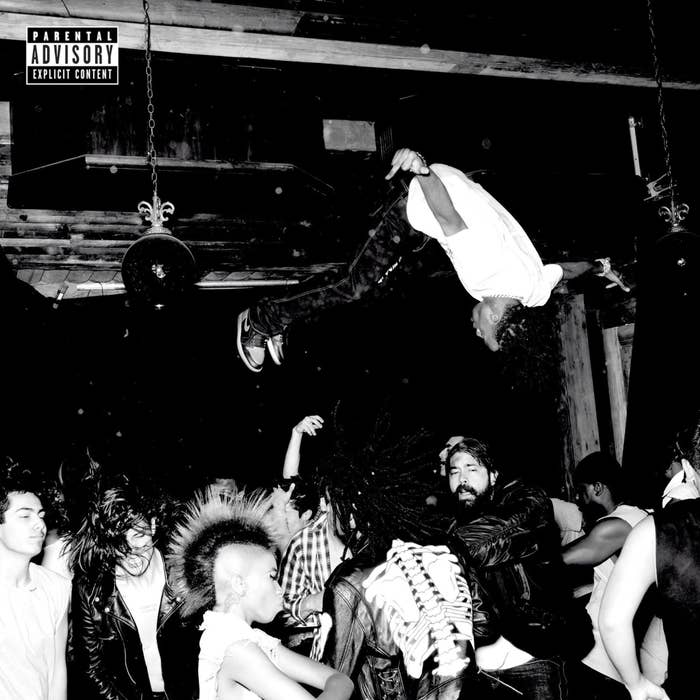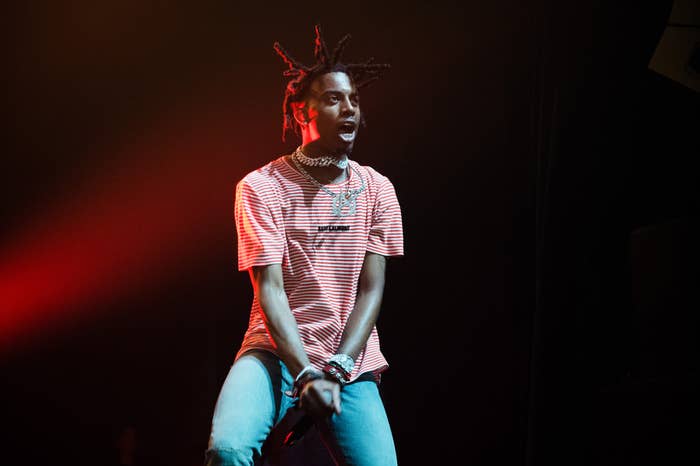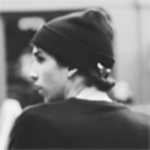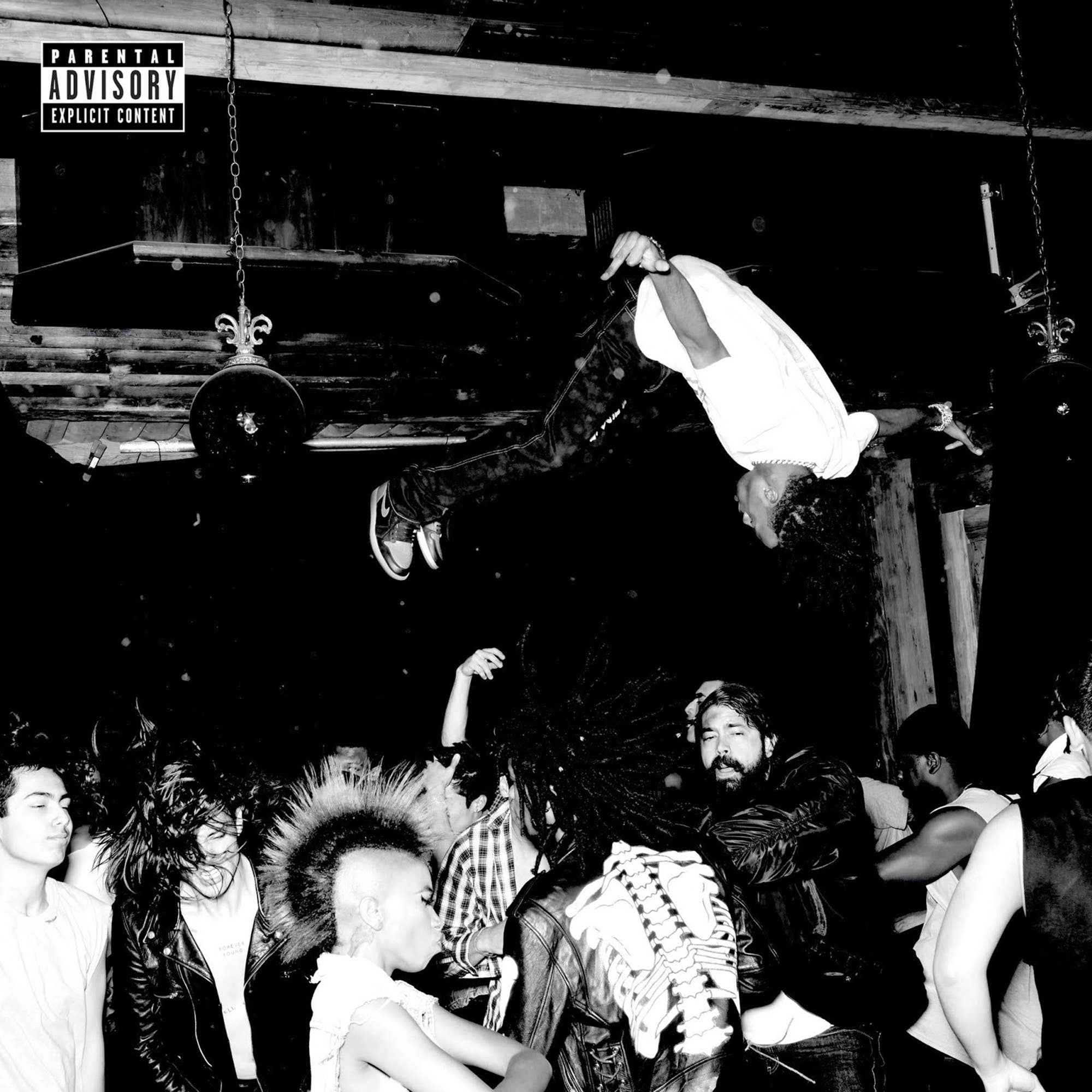
Playboi Carti's new album, Die Lit, is all about capturing a mood.
Throughout the 19-song project, Carti and Pi'erre Bourne are guided by feeling more than anything. With a minimalist approach to songwriting, Die Lit favors woozy basslines and chirping ad-lib over complex lyrical themes. It's a raw, stripped down album that takes the traditional idea of hip-hop and stretches it new directions.
An album like Die Lit needed a perfect cover to set the right visual tone. So Carti and his team reached out to photographer Nick Walker, who has a diverse background shooting videos and photos for rock, rap, and R&B artists like FKA Twigs, Future, Nicki Minaj, Beyoncé, Mac DeMarco, Hanni El Khatib, Trash Talk, Rae Sremmurd, and Freddie Gibbs.
The concept of the cover was based around a reference photo of an old punk rock show found by Midnight Studios art director Shane Gonzales. "So many of these hip-hop shows now have that energy from punk shows back in the day," Walker says. "Carti's music really goes against the grain, too, just like punk used to do back in the day. He's into a bunch of different music and things like that, so it was a really easy pairing."
"I grew up listening to a lot of punk rock and going to a lot of punk rock shows, so I knew I could execute it in an authentic way," Walker adds. So he played punk music "really fuckin' loud" as Carti hurled himself into the air until they had the perfect image to match the Die Lit title. Walker explains that he always prefers his shoots to have a loose energy and gravitates towards an "unhinged" style. In other words, he was the perfect match for Carti.
Continue for our interview with Walker and read the full story behind the Die Lit cover.

How did you get linked up with Carti’s team for this?
I've been working with Interscope for over ten years. They kind of gave me my start into my first proper big photography jobs. They're family. So I got linked up with Carti's team and I went out to New York to meet him and catch a vibe. We got on really well and they needed to shoot the cover.
They had a reference image of a punk show. I grew up listening to a lot of punk rock and going to a lot of punk rock shows, so I knew I could execute it in an authentic way. And I also knew how to execute it from a workflow perspective. I came home on Sunday, got the email on Monday, and they asked if we could do it on Thursday. So we made it happen. Shane Gonzalez from Midnight Studios was the one who helped with creative, in terms of finding that photo. He came on to help style it. It was a really great team.
When you met with Carti, did he tell you what he was going for?
Yeah, we talked about the project and the energy he was going for. He's got a lot of insight, and he's one of those really great artists to work with who know what they want. So I just had to figure out how to achieve it and make it all work.
Anybody who's been to a Carti show or a really lit show should be able to recognize the feeling and relate to the image.
So the main mood you were going for was just that punk energy?
Yeah. It was punk. So many of these hip-hop shows now have that energy from punk shows back in the day. Carti's music really goes against the grain, too, just like punk used to do back in the day. He's into a bunch of different music and things like that, so it was a really easy pairing.
Where did you guys shoot it?
We shot it at this great photo studio at Highland Park called The Forge. One of the studios has great woodwork. I knew it needed to be dark and we had to create the atmosphere of a show, so that's what we did. We hung up some black duvetyne to hide some of the interior of the studio and played music really fuckin' loud. Then we kind of let the offense run itself, you know?
Carti is in a really interesting pose. How’d you guys pull that off?
Yeah, I'd shoot a few photos. Then we'd see, like, damn, it looks better when his legs are extended or his body is more twisted or whatever. We really didn't shoot that many, though. Once we got that one, it just kind of felt like the one.
This photo bridges the worlds of rock and rap in a really natural, effortless way. I was looking through your other work and it seems you’re just as comfortable shooting someone like as Hanni El Khatib or Dan Auerbach. Do you think that helped with this project?
Yeah, definitely. It's interesting because even in high school I was friends with a lot of different people. I've always liked to understand everyone's scene and not just walk into someone's scene and not know anything about it. I think it just relates to who I am, and that's why I'm able to shoot different people in different genres. I'm also able to fit artists in the context of a different genre that doesn't necessarily fit with them, but do it in a way that makes sense for them. You know, with a lot of these musicians, you forget that they love all kinds of music, too. You can talk to Hanni El Khatib about every current rapper out right now. And every old one, too. I think it's really just about listening to people and giving respect to each genre in its own way. I'm there to help connect the dots.
Do your own musical tastes reflect what your portfolio looks like? Are you all over the place? Or what are you usually listening to?
Yeah, I'm all over the place. I hate it when people say, "I love everything," but I really do. If anyone's doing something really well, I gravitate to it. I love rap, I love rock, I love electronic, I love even poppy-er stuff, too. If it's a banger, it's a banger, you know? I don't discriminate. But as far as my portfolio goes, it's tough not to have a lot of rap up these days, because it's so big and there's a lot of clientele. I try to keep the portfolio cohesive, stylistically, but have lots of different things. There's so much out there to enjoy in the world, so why limit yourself to one thing?
When I look at this photo, I get a raw, powerful, energetic feeling. Do you naturally gravitate towards those types of images?
Yeah, "unhinged" to me is everything I like in anything creative. It doesn't need to be ratchet or anything, it just needs to be a little unhinged. If there's a looseness to a shoot, it will allow something to grow organically from the situation and maybe something unexpected will happen. That could be imagery, music, or even a conversation. I still love a beautifully composed image, but for me there's got to be something a little unhinged. I always like to put people in different light. Sometimes that's an actual physical light. Like, if I have a celebrity I'm going to shoot, I might have their face full in darkness, which could be something new for them. Or just put them in a different light in, like, a new way to look at them. I'll put them in a new environment or something that you typically wouldn't see.
he main thing I drew inspiration from is my past. I've never done a flip off a stage, but I've climbed 30 feet up onto a rafter and jumped off before. I've been in a ton of pits.
I saw in the comments, lots of people are saying they think that’s Dave Grohl in the photo. It doesn’t totally look like him to me, but I’ve gotta ask… is it?
[Laughs]. No, but that would be sick if it was. That would be hilarious.
What were your main influences or reference points for this image?
Shane had the first image from the old punk show, and that was really the only image. The main thing I drew inspiration from is my past. I've never done a flip off a stage, but I've climbed 30 feet up onto a rafter and jumped off before. I've been in a ton of pits. It was important for me to get a good assortment of people in that pit that really would be there. I used to be 5'8'' and 132 pounds and I would get bounced around in there. So it was like, it can't just be a bunch of big dudes in there, we need to have some smaller people in there, too. We need to have all different sorts of people. I went to a lot of shows growing up, so I just thought if I could recreate that, then I'm good.
You said you were playing music really loud at the shoot. Was it Carti's music or punk or what was the vibe?
It was mostly punk. Old and new. Also, shout out to everybody who showed up and did it because they really went ham. That's tiring, man. They really gave it their all.
You mentioned the shot was styled by Shane Gonzalez. How collaborative was the project and what was his involvement?
Yeah, it was cool. This was my first time working with Shane and honestly we just clicked really easily. He does everything really well and I take pride in my work, too. When you get to work with another person who cares as much about what they're doing as you do about what you're doing, it's really easy. He had a relationship with Carti before this, so it was great to be working with someone who was familiar with him and already had a working relationship. Again, I feel like it was a really great team that was put together. Honestly, it was all super smooth. There are so many jobs where nothing falls into place and you're constantly trying to do damage control to get back on track. This was one where everything fell into place, though.
When you look at the final cover, what comes to mind for you?
I relate to it. I've been there. Anybody who's been to a Carti show or a really lit show should be able to recognize the feeling and relate to the image.
We've mainly talked about your music-related work, but what are some of the other things you've worked on?
Yeah, I like doing documentary stuff a lot. I recently did a project that I'm really proud of called "The Baltimore Dance Project" with FKA Twigs. There are probably like five documentary ideas that I'm always trying to do. I'm going to be going out to the Atacama Desert in Chile in August to work on a potential nature documentary. And commercial work, too. I'm just dabbling in it all. At the end of the day, I just like to shoot, whether that's a still image or a video. If the opportunity is available and I have the time, I'll just head out somewhere and take pictures without even knowing the end goal for it. I just know the inspiration is there so I've got to see it out.
How did you originally get into photography and videography in the first place?
I grew up out here in LA in the San Fernando Valley. My dad did concrete and my mom did banking, so there was really no kind of blueprint into the creative field, but I always loved taking pictures. I would get disposable cameras and get them printed and give them to my mom or whatever. I was always hanging those pictures up and putting them on my wall. At the time, I didn't really think anything of it, but in hindsight now, I was obviously very attracted to imagery. But back then I thought if you were a photographer it just meant you sold prints down at Venice Beach and you were a hippy. I knew that wasn't for me, so I just chugged along.
I took a TV production course my senior year in high school, where we got to edit stuff. Also, in hindsight, with my dad being in construction, it was really cool for me to see all my work pay out into a tangible product. After learning very minimally how to edit, it was cool to be like, "Yo, I did this, and we can watch it right now." That was really fulfilling for me.
I always want to put some kind of humanizing quality into anything that I do.
I went to junior college for two years in San Diego, then I transferred to a school in New York City called Pace University and I majored in business. When I got out there, my mom had a client at her bank who owned a photo studio in New York and she was like, "My son's out there and he's into creative things and he doesn't really know what to do," or whatever. So he got me a job where I did anything and everything. I picked up props, cleaned the floors, whatever. I was on set one day around the time digital photography had just started. It was all film and polaroids at the time. I saw a polaroid and I was like, "What? Holy shit, this is the finished product? This looks nothing like what I'm looking at right now." So I told the studio manager I really wanted to get on set and start learning.
Long story short, that company went bankrupt. When I was leaving, there were a bunch of photographers outside and they asked if I was looking for work and offered me a job assisting. I was really fortunate to have this guy Jessie Winter hit me up and take me under his wing. That was basically my last year of business school. I started learning about lighting and stuff like that through him. I owe him a lot for being willing to do that. When I graduated, I was like, "Okay, cool, I'll try this freelance thing out here in New York." So I was getting assisting gigs for about a year and a half. Eventually I went broke and came home. Fortunately, home is LA, and I was able to get in the photo industry out here and link up with some really great photographers.
The plan back then was to become a big photographer and diversify. You'd start directing music videos and eventually commercials, then maybe features if you wanted to. But as the world and technology changed, these opportunities popped up for me to do videos for photographers I was working for. So I started doing video, which gave me even more opportunities. I was able to start doing photography full time, and then I was able to get a little more particular about the projects I wanted to take on. And that kind of leads us up to here.
I noticed you've worked with a lot of musicians. How did you head down that path?
I've always been super passionate about music. You know, when you start off, you kind of want to shoot everything. You don't want to get pigeonholed. You don't want to be pigeonholed as "this guy who does this," because you can do so many other things. But music kept coming back into my orbit of opportunity, until eventually I was like, yeah, it makes sense. When I listen to music, I see things. Not like a schizophrenic.[Laughs]. But like, I can imagine certain imagery for things. So I thought, I shouldn't fight this. I should just own it. I still like to shoot a lot of different things, but I have a lot of friends who are musicians and who are in that scene, so it just made sense.
Are you mainly doing photography or videography these days? What's the split?
Last year, I primarily just directed. But before, I would say it was like 75% photography and 25% directing. Last year, for whatever reason, directing just took over more. This year it's been about 50/50. I'm just always super grateful. I never thought this was a shoe-in for me. Every day that I wake up and I get to go take a picture or direct a video or whatever else, I'm just super grateful. So I'll just let life take me where it takes me. If I end up doing more videos, great, then I'll do more personal photography projects. And vice versa. My whole thing is I just like to do the work. I don't want to waste time thinking about what I should be doing more or less of. I just kind of work from the gut. If I have something that I want to do that's a still image, then I'll go do it. And if I have something I want to do that's a video, then I'll go do it.
I like offbeat things that people don't necessarily think are interesting until you put some light on them.
Would you say there's a common thread that runs through all the things you do? Is there anything that ties it all together?
The goal for me as an image maker is to keep things cohesive. So when you do see something you might be able to say, "Oh, damn, that looks like maybe Nick Walker did it." But yeah, I like offbeat things that people don't necessarily think are interesting until you put some light on them. I like to find the things that maybe aren't as obvious to think about right away.
What I'm really learning about myself is that I always want to put some kind of humanizing quality into anything that I do—whether that's doing something that you're quote-unquote "not supposed to do" or doing it "the right way." I try to bring a humanizing quality to the images so that we can all relate to them. Or maybe not everyone can relate, but at least one person will be like, "Oh damn, I get this."
Is there anything coming up that readers can look forward to from you? Or is there a place they can keep up with you on future work?
Yeah, there's a bunch of stuff in the pipeline from some artists I can't totally talk about. A finished project will be releasing really soon. I wish I could say more, but you can keep up on my Instagram. I'm not that good about keeping it up to date, because I'd rather be busy than doing that, but it's @nickwalkerstudio. And my website.



